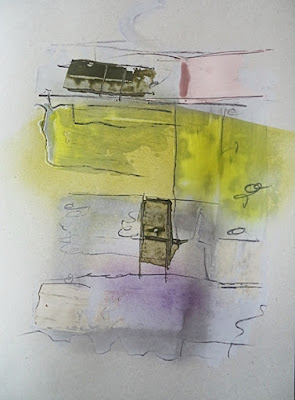Painting =
FIVE
Golden Rules
Here are five golden rules for the socio-cultural practice or the activity of painting when it is exercised in the Western Tradition of Fine and Visual art
more specifically the genre of painting. These rules concern the artist as a whole, his Self, constructions of reality, social relationships, values,
norms, attitudes, emotional and intellectual development, beliefs, etc. These are things he will get in order during his life time, for as Socrates
is alleged to have said, "an unexamined life is not worth living". He will obviously question himself, his pre-suppositions and assumptions
concerning all aspects of existence. It is in this totality of his existence that the subtlety and complexities of these rules should be interpreted,
understood and individuated by each person.
(1) The artist is totally, completely and absolutely authentic (and increasingly so) in his entire being and all areas of his existence.
(2) S/he is unintentionally and naturally original and unique in his approach to and understanding of reality (internal and external realities), the
discourse of art, the socio-cultural practice of Fine or Visual Art and painting.
(3) S/he is naturally and intentionally questioning, reflective and aware of the subtle problematics of all things, phenomena and situations.
(4) A work of art makes one, clear statement.
(5) The real aim of a work of art is to be, subconsciously so, an emotional punch, a KO through and as 'feeling'.
1) He should learn to be authentic in all areas of his existence, he must endlessly question and examine himself, his Self, and entire existence. With
this refined and highly developed skills of self-examination, that have become second nature to him and/or be applied sub-consciously all the time,
he should approach his artist reality. This exercise will assist him to become increasingly truthful to himself, both in his entire existence and all
aspects of his being and obviously in his artistic practices.
2) He will increasingly become unique in all areas of his existence and obviously in his original artistic work. This most definitely does not mean that
he will use or abuse art to shock, merely attempting to attract attention and become in/famous. For an artist to be original it is essential that he explores
and develops many aspects of the discourse and processes of painting, for example techniques, different media, supports and the structural or formal
aspects of painting (such as color, composition, form, etc.)
3) His painting and his attitude towards painting will reveal that he, similar to creative thinking and questioning individuals in all socio-cultural
practices and specialized discourses (for example, philosophy, natural and social sciences, visual and performance arts, mathematics, theology,
composition of music, etc) and all areas of daily existence (for example parenting, work, leisure, relationships, beliefs, etc), investigates and
explores phenomena and do not merely accept them on face-value, or the way they are constructed, perceived and understood by his time and
place - his culture and sub-culture, class, age group, personality-type and other socio-cultural, psychological, biological and human factors. In
other words he will be experimental, explorative and questioning and able to interpret and translate everything as problems, by systematic, logical
and controlled problematization or problematizing. He will continually and constantly have a reflective, questioning and open frame of mind and
reference towards all aspects of existence and his own artistic practices. He would deal in depth with the formal and structural aspects of his work
(and all aspects of his existence, for example the re/construction of his external environments as well as his inner worlds) be it in painting itself
(for example the exploration of certain aspects of painting by working in series), drawing, installations, performance, photography, videos and
other new media.
4) Every single one of his paintings will make one, clear statement. This point and the next point (5) are really the different sides of the same coin. In fact
all 5 points are merely different perspectives on or views of the 'same' object, for example perceiving a house (and architectural plans of it) from the front,
the top and the different sides.
5) All socio-cultural, personal, structural and formal aspects concerning a painting will work together in unity, or disunity (some aspects of the work might
be 'slightly off' and intentionally so) with the single purpose and sole aim to convey an 'emotional or feeling-based' punch or KO. This, is the real aim and
overriding purpose of every work of art - the pre-conceptual,(conceptually) ineffable, emotional, feeling expression or 'message' it conveys, expresses and
communicates.










No comments:
Post a Comment
Note: only a member of this blog may post a comment.